Raised Garden Beds – 5 Tips for Surefire Success
This post may contain affiliate links. Read my full disclosure here.
Raised garden beds can be an excellent addition to the garden. We’ll share how to build raised beds the right way to help extend your growing season and make gardening easier.

A raised garden bed is where the soil and plants are raised up above the surrounding soil or surface. In most cases, the bottom of the bed is open to the ground, not closed off like a container. That said, you can set garden boxes up on a patio or other hard surface.
Pros and Cons of Raised Garden Beds
Pros:
- Raised beds work especially well if you have poor drainage, or hard, compacted soil.
- Raised bed gardening can make it easier to care for your plants, with less bending and stooping.
- Working in beds instead of rows means you only add soil amendments right where you need them, not to paths or walkways.
- They can be orderly and beautiful as well as practical. You’re only limited by your imagination and available materials.
- Raised garden soil dries out and warms up sooner in spring, helping you get a jump on the growing season.
Cons:
- If you opt for a taller bed (and not simply mounding soil), materials to build your raised garden bed can be an added expense.
- The same dryness and warmth that is a boon in early spring can be a problem in the hot, dry weather of summer. Make sure to mulch and water as needed to avoid plant stress.
- If you use walls, eventually they need to be replaced. You’re not likely to be able to easily use power tools (like a tiller) in a raised garden bed. Plan accordingly.
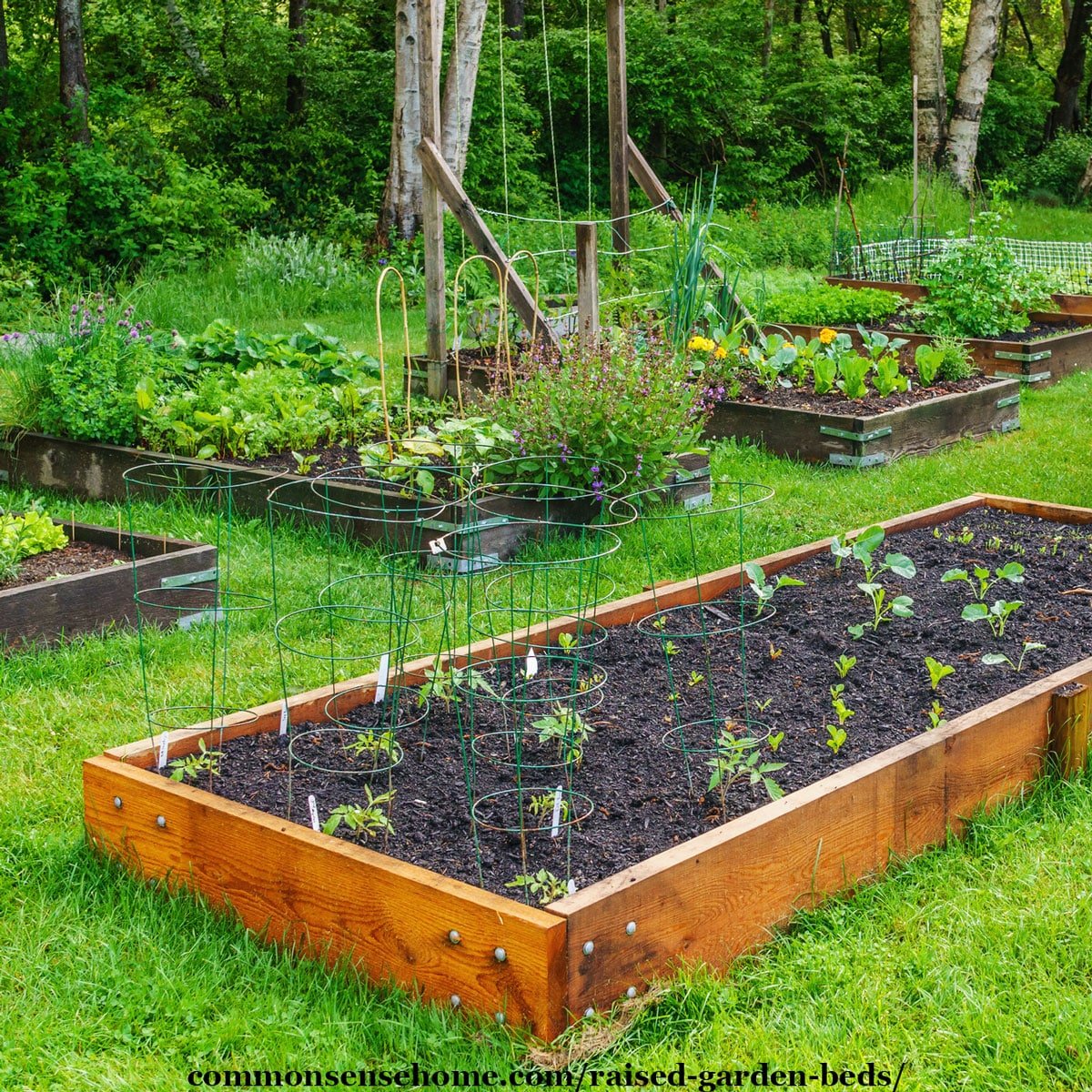
#1- Choose the Right Raised Bed Size
How wide should a raised garden bed be?
Make sure you can reach the middle of each bed without having to step on or enter the bed. If you make the bed too big, you might damage crops while reaching into the middle of the bed when weeding and harvesting.
A good rule of thumb is to make the bed three to four feet wide. This allows you to reach the middle of the bed from both sides, depending on your height and arm length. If in doubt, opt for a three-foot (1 meter) width.
How long should a raised garden bed be?
Work with the space you have. Those with a large gardens using mounded soil raised garden beds may want to go up to 15 feet (5 meters) on the long side.
If you’re building high sided beds, like metal or cedar raised beds, material comes in 8 foot lengths. Beds 8 feet long of 4 feet long may be a better choice.
Your raised garden beds don’t have to be rectangular. It’s your garden, so do what works best for you.
If you want a decorative bed, build a circle or curving bed, like this spiral herb garden. Need to fill in a corner? How about a triangular bed? As long as you can reach all parts of the bed for care and harvesting, you’re good.
#2 – Choose the Right Raised Garden Bed Depth
How deep should a raised bed garden be?
The depth you choose depends on the crops you plan to plant. Remember, if a plant is root-bound or can’t develop its root system, it won’t grow or produce as large a harvest.
If your bed is over six inches above ground, you’ll likely need walls and or a support system to keep the soil from eroding and spilling out.
Rule of Thumb: Healthy plants often spread out as much or more below ground as they spread above ground. Most raised beds with walls are at least 12 inches tall.
If you opt for extra deep raised garden beds that are 2-3 tall, remember that they need to be filled with soil, either from your land or brought in.
Another option is to layer high quality organic material like leaves and spent bedding to compost in place, while topping off the beds with high quality potting soil to plant in.
In the book “The Vegetable Gardener’s Bible”, Ed Smith aims for 18 inches of good quality, loosened soil for plant growing. He uses a combination of deep tilling with raising the soil in the beds about 6-8 inches above the surrounding soil.
#3 – Pick the Right Support and Wall Options
Remember, mounded soil will usually stay in place if it is no more than 6-8 inches above the surrounding pathways. If you want a taller bed, you need support. Raised garden beds can be supported by:
- Planks
- Plastic wood
- Stones
- Concrete Blocks
- Metal sheets
- Raised Garden Bed Kits
- Other materials
Larger rocks make excellent walls because they never break down or need replacing, but they can be tricky to stack. Concrete blocks are sturdy and affordable, but less decorative. If you have the budget for it and your garden is a focal point in your landscape, retaining wall bricks stack well and look beautiful.
Would you like to save this?
Stone and brick also retain warmth, which is good in cooler climates and early spring but not necessarily a good thing in droughts or the heat of summer.
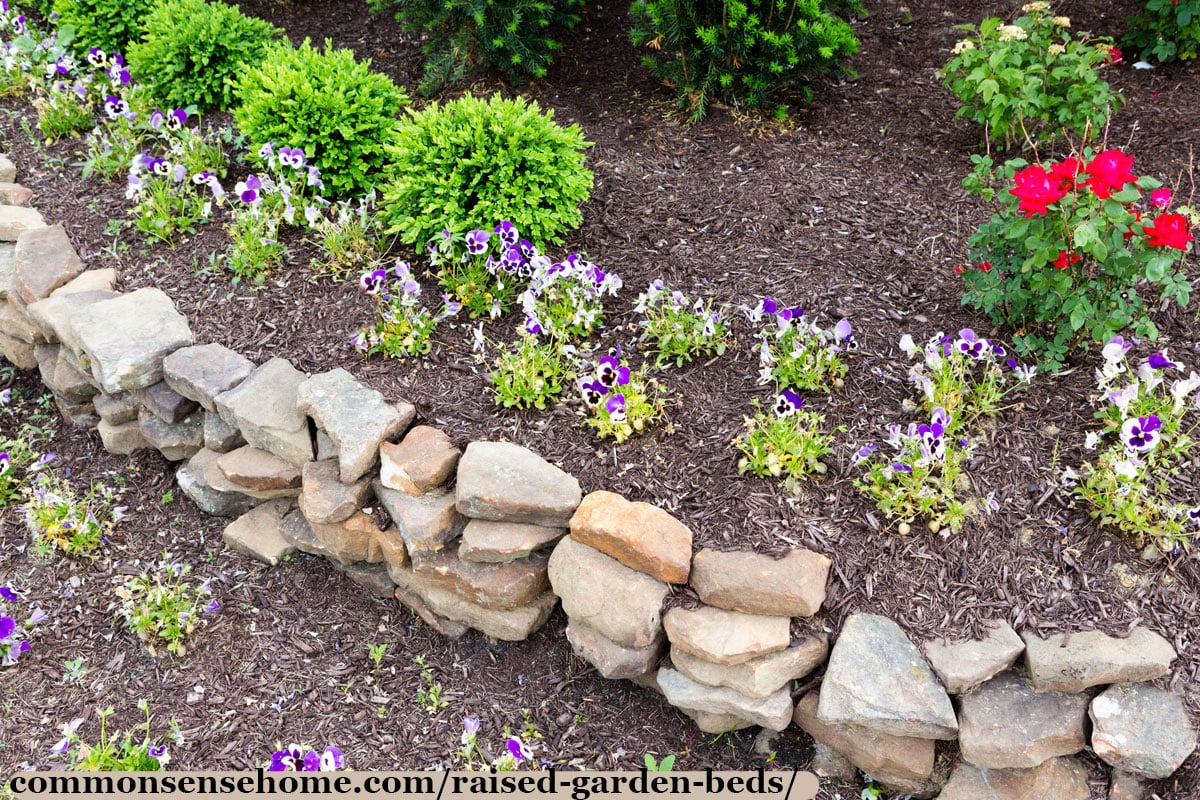
Rot-resistant lumber such as cedar or redwood is also a good choice. I have heard cedar may be toxic to plants, but research from Washington State University says this is a myth. There’s no documented evidence that cedar bark releases chemicals that harm other plants.
I recommend avoiding pressure-treated lumber, especially when treated with creosote.
Metal raised garden beds have become more popular because of cost and ease of assembly. They work well in some areas, but are probably not a best choice if you have hot, dry summers.
#4 – Lining or No Lining?
Do I need to line my raised garden bed?
The use of a liner depends on the type of material you choose to build your retaining walls with, specifically alternatives like brick and cinder blocks or lumber treated with creosote.
You might also want to use a liner if your raised garden bed walls have gaps between stones or pieces of wood, to help hold the soil inside the bed.
Some people are concerned that chemicals from concrete, especially cinder blocks containing fly ash, may leech into the soil. I was unable to find any scientific studies regarding this one way or the other.
If you decide to use a liner because you are concerned about chemicals leeching, line the inside of the garden bed walls with a BPA-free, six-millimeter plastic liner. Make sure you only line the walls and not the ground, for proper drainage.

If you decide to line your raised garden beds to hold the soil in, line the walls with landscaping fabric. This allows the soil to breathe and not wash out in the rain, while still keeping it inside the bed.
If you are putting your raised garden bed directly on grass or weeds – line the bottom of the bed with cardboard or several layers of wet newspaper to smother the plants before filling the bed with soil.
The cardboard or newspaper will rot down and compost, saving you a lot of work work digging up the soil. Over time, as you add more organic matter to the bed, the worms and bugs should loosen the soil beneath the bed.
#5 – Use the Right Plant Spacing in Raised Garden Beds
Here’s one of the areas where raised garden beds outshine traditional rows. Instead of planting a single row of plants, with a wide path, you can plant a wide block of plants with a relatively narrow footpath.
This means you can fit it two or three times the amount of vegetables in the same space.
To plan your plant spacing inside a raised garden bed, space plants or seeds roughly the same distance apart in all directions.
For instance, if I normally plant my onions 3-5 inches apart in rows, then I space the onion rows in my wide raised bed about 5 inches apart.
Ideally, as plants grow, you want their leaves to spread and shade most of the raised bed. This helps to shade out weeds, and keep the soil cool in summer. (Again, don’t forget to mulch and water as needed.)
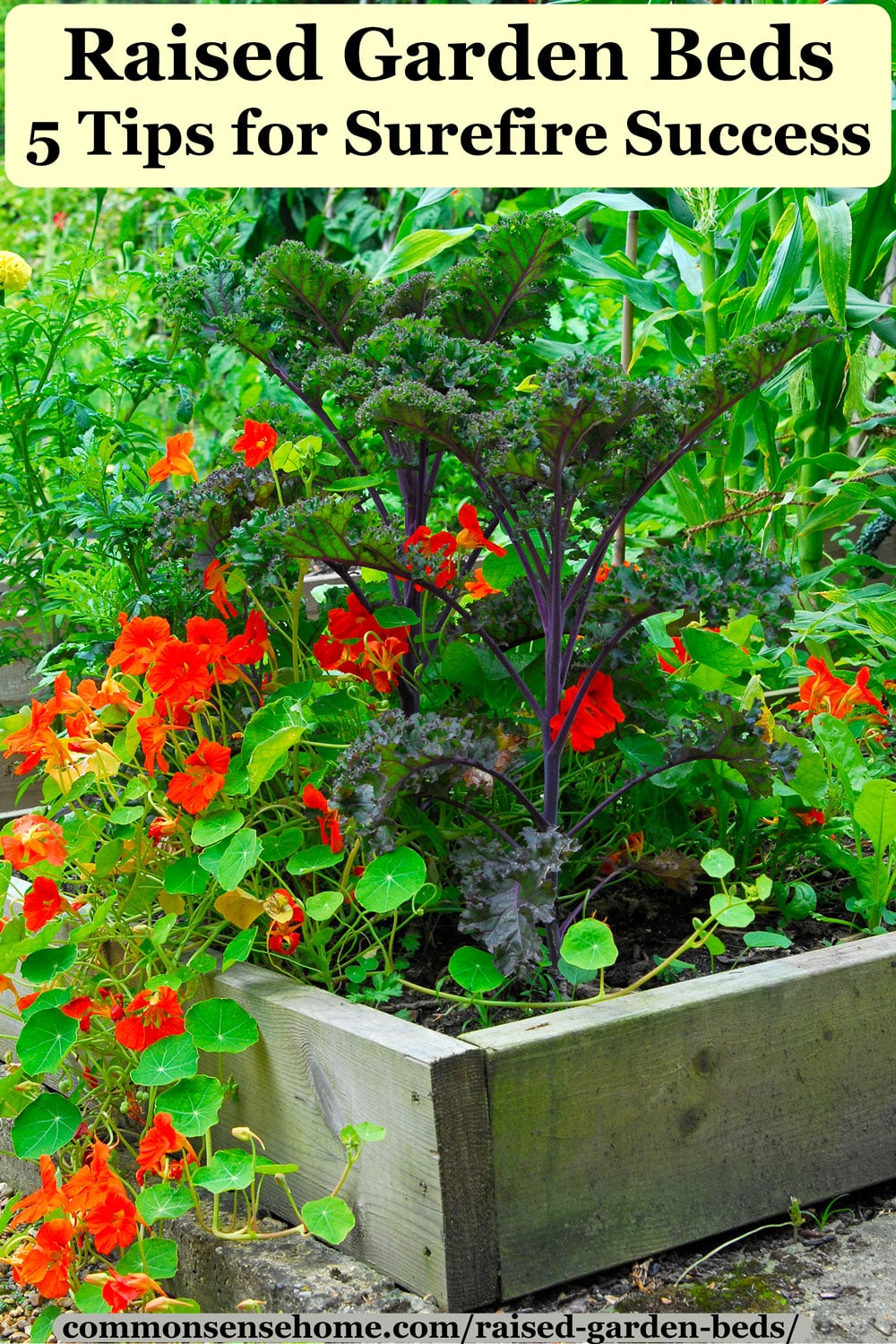
Are you ready for your best garden ever?
Raised garden beds can be a great addition to help you grow more food at home, especially if you have trouble bending or stooping or have poor soil. If you get hit with heavy rains, they could make the difference between getting and crop and plants rotting in the garden.
My friend, Melissa Norris, helped write this post. Melissa’s new book, The Family Garden Plan, is now available at amazon.com and other retailers.
In this book, you’ll learn how to grow a year’s worth of food for your family. Melissa’s book includes step-by-step plans and charts, plus bonuses on crop rotation and companion planting! All methods are natural and organic.

As a special “thank you”, Melissa is offering several bonuses with your purchase of her book, including:
- Crop Rotation & Companion Planting Videos $29 value
- Seed Saving 101 Video & e-book Package $29 value
- Organic Soil Amendment Guide $19 value
Just order your copy of The Family Garden Plan, then visit The Family Garden Plan Page on Melissa’s website and enter your proof of purchase information.
We hope you’ve found this post helpful. If you have more gardening questions or tips, please leave a comment below, and feel free to poke around the Common Sense Gardening page for a full list of gardening articles on the website.

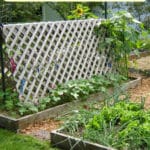
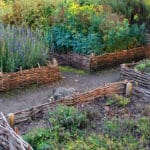

I’m using plastic rain gutter downspouts for a raised bed. They’re being held together by threaded rods and stacked “Lincoln Log style”. I’ve used cedar planks but here in Florida any wood that touches the ground become lunch for termites. I’ve also learned that once your raised garden wood planks have termites, the termites also head for your Turnips. It’s not fun pulling up a healthy looking Turnip only to find termites coming out of little holes that they’ve dug into your Turnip.
Thanks for sharing your experience. No termites here (or at least, not many), so I haven’t had to contend with them, but I’ve seen videos and photos of the damage they can do. I did not know that they like turnips.
You could try sprinkling food grade Diatomaceous Earth around the base of the raised bed and mix in with the dirt along the sides too.
You will have to replace it after it rains but it will keep those pests away.
To offset the expense of trying to fill up a tall raised bed I added old rotting limbs as a bottom layer then added leaves that I raked up from my yard, as that rots down I add peat moss and garden soil to top it off.
Yes, anything that rots down and is not toxic should work.
And best of all, its free!
Which is just the right price. We’re in an old farm pasture, so not much in the way of trees available for salvage, but sometimes we can get odds and ends from neighbors.